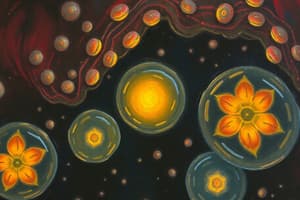Podcast
Questions and Answers
What is the primary function of the plasma membrane?
What is the primary function of the plasma membrane?
- To synthesize proteins
- To provide structural support to the cell
- To separate the cell from its environment (correct)
- To store genetic material
Which organelle is responsible for protein modification and transport?
Which organelle is responsible for protein modification and transport?
- Mitochondria
- Endoplasmic reticulum
- Lysosomes
- Golgi apparatus (correct)
What type of transport requires energy input?
What type of transport requires energy input?
- Simple diffusion
- Facilitated diffusion
- Passive transport
- Active transport (correct)
Which type of cell signaling involves direct interaction between cells through gap junctions?
Which type of cell signaling involves direct interaction between cells through gap junctions?
What is the primary function of lysosomes?
What is the primary function of lysosomes?
Which stage of the cell cycle includes DNA replication?
Which stage of the cell cycle includes DNA replication?
What is the term for the series of molecular events that transmit signals?
What is the term for the series of molecular events that transmit signals?
Which type of receptor has enzymatic activity?
Which type of receptor has enzymatic activity?
Flashcards are hidden until you start studying
Study Notes
Cell Structure
- Plasma membrane: semi-permeable membrane that separates the cell from its environment
- Composed of phospholipid bilayer with embedded proteins
- Cytoplasm: jelly-like substance inside the cell membrane
- Site of many cellular activities, including metabolism and protein synthesis
- Nucleus: control center of the cell
- Contains DNA, the genetic material
- Mitochondria: energy-producing organelles
- Site of cellular respiration, generating ATP
- Endoplasmic reticulum (ER): network of membranous tubules and cisternae
- Involved in protein synthesis, lipid synthesis, and detoxification
- Golgi apparatus: complex of flattened sacs and tubules
- Responsible for protein modification, sorting, and transport
- Lysosomes: membrane-bound sacs containing digestive enzymes
- Involved in cellular digestion and recycling
- Cytoskeleton: network of filaments that provides structural support and shape
- Composed of microtubules, microfilaments, and intermediate filaments
Cell Membrane Transport
- Passive transport: movement of molecules from high to low concentration
- Includes diffusion, osmosis, and facilitated diffusion
- Active transport: movement of molecules from low to high concentration
- Requires energy input, often through ATP hydrolysis
- Types of membrane transport:
- Simple diffusion: movement of molecules through the phospholipid bilayer
- Facilitated diffusion: movement of molecules through transport proteins
- Active transport: movement of molecules through pumps and carriers
- Endocytosis: uptake of molecules through vesicle formation
- Exocytosis: release of molecules through vesicle fusion
Cell Signaling and Communication
- Signal transduction pathways: series of molecular events that transmit signals
- Involves receptors, signaling molecules, and response elements
- Types of cell signaling:
- Autocrine signaling: signaling within the same cell
- Paracrine signaling: signaling between nearby cells
- Endocrine signaling: signaling between distant cells through hormones
- Direct signaling: direct interaction between cells through gap junctions
- Receptors: proteins that bind to signaling molecules
- Seven-transmembrane receptors: G-protein coupled receptors
- Tyrosine kinase receptors: receptors with enzymatic activity
Cell Cycle and Division
- Cell cycle: series of stages that a cell goes through to replicate and divide
- Includes interphase (G1, S, G2) and mitosis (M)
- Mitosis: process of cell division that results in two daughter cells
- Includes prophase, metaphase, anaphase, and telophase
- Cytokinesis: process of cytoplasmic division
- Occurs after mitosis, resulting in two separate cells
- Regulation of the cell cycle: controlled by checkpoints and regulators
- Ensures that DNA replication and division occur accurately and efficiently
Cell Structure
- Plasma membrane: semi-permeable membrane that separates the cell from its environment, composed of phospholipid bilayer with embedded proteins
- Cytoplasm: jelly-like substance inside the cell membrane, site of many cellular activities, including metabolism and protein synthesis
- Nucleus: control center of the cell, contains DNA, the genetic material
- Mitochondria: energy-producing organelles, site of cellular respiration, generating ATP
- Endoplasmic reticulum (ER): network of membranous tubules and cisternae, involved in protein synthesis, lipid synthesis, and detoxification
- Golgi apparatus: complex of flattened sacs and tubules, responsible for protein modification, sorting, and transport
- Lysosomes: membrane-bound sacs containing digestive enzymes, involved in cellular digestion and recycling
- Cytoskeleton: network of filaments that provides structural support and shape, composed of microtubules, microfilaments, and intermediate filaments
Cell Membrane Transport
- Passive transport: movement of molecules from high to low concentration, includes diffusion, osmosis, and facilitated diffusion
- Active transport: movement of molecules from low to high concentration, requires energy input, often through ATP hydrolysis
- Types of membrane transport:
- Simple diffusion: movement of molecules through the phospholipid bilayer
- Facilitated diffusion: movement of molecules through transport proteins
- Active transport: movement of molecules through pumps and carriers
- Endocytosis: uptake of molecules through vesicle formation
- Exocytosis: release of molecules through vesicle fusion
Cell Signaling and Communication
- Signal transduction pathways: series of molecular events that transmit signals, involves receptors, signaling molecules, and response elements
- Types of cell signaling:
- Autocrine signaling: signaling within the same cell
- Paracrine signaling: signaling between nearby cells
- Endocrine signaling: signaling between distant cells through hormones
- Direct signaling: direct interaction between cells through gap junctions
- Receptors: proteins that bind to signaling molecules
- Seven-transmembrane receptors: G-protein coupled receptors
- Tyrosine kinase receptors: receptors with enzymatic activity
Cell Cycle and Division
- Cell cycle: series of stages that a cell goes through to replicate and divide, includes interphase (G1, S, G2) and mitosis (M)
- Mitosis: process of cell division that results in two daughter cells, includes prophase, metaphase, anaphase, and telophase
- Cytokinesis: process of cytoplasmic division, occurs after mitosis, resulting in two separate cells
- Regulation of the cell cycle: controlled by checkpoints and regulators, ensures that DNA replication and division occur accurately and efficiently
Studying That Suits You
Use AI to generate personalized quizzes and flashcards to suit your learning preferences.




